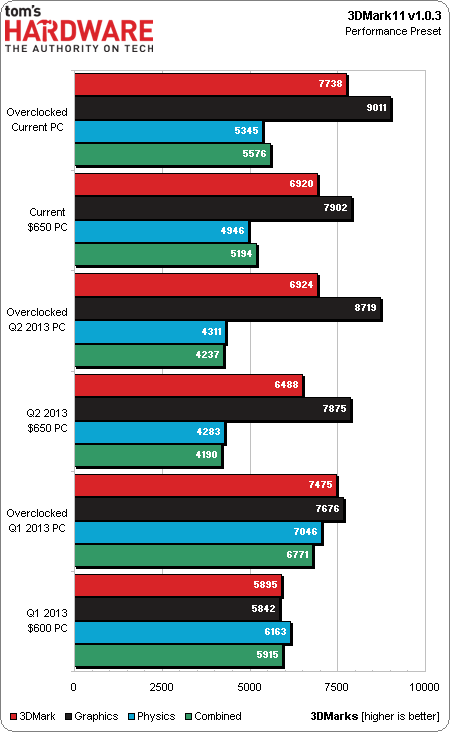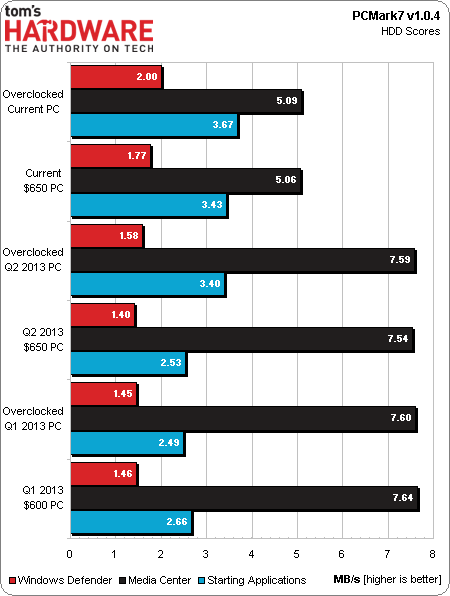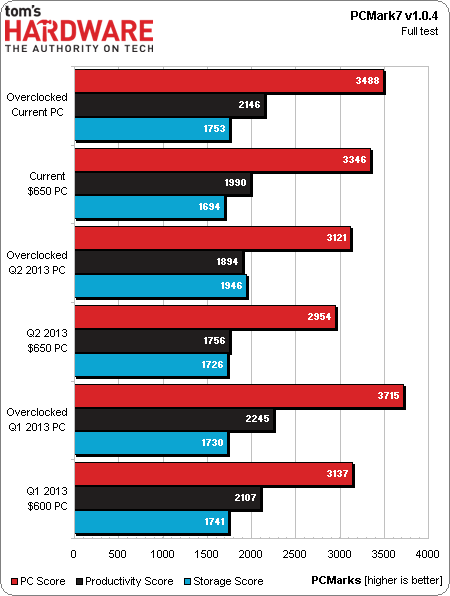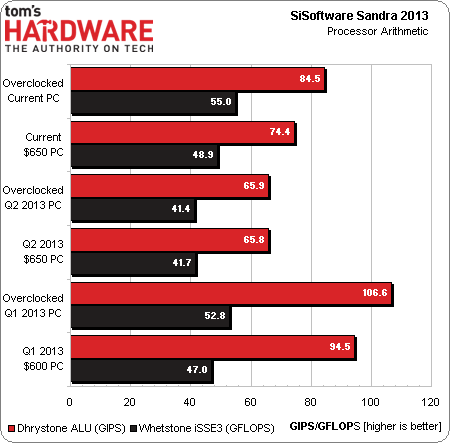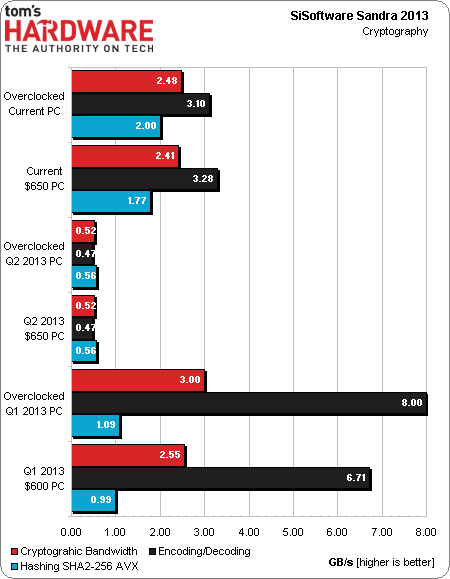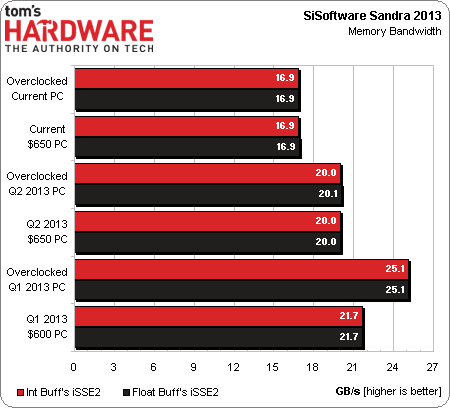System Builder Marathon, Q3 2013: $650 Gaming PC
Results: Synthetics
As I was writing the introductory text, I realized it wasn’t enough to compare today's PC to last quarter’s Core i3-based mini-ITX build. No, I was expecting huge things from this machine. So, I added all of the data I had for the $600 build from earlier this year, which sported a more expensive Core i5-3350P married to milder Radeon HD 7850 graphics. Because we can’t afford a K-series Core i5 at this budget level, both processors pretty much round out what Ivy Bridge can do against AMD’s FX-6300.
Synthetics
The six-core Vishera-based CPU reclaims much of what we gave up last quarter in 3DMark 11’s Physics and Combined tests, yielding an overall higher 3DMark score. Today's overclocking efforts give us a higher graphics score also. Overall, this is a good start for our current gaming PC.
PCMark7 exposes the limitations of our mechanical hard drive, but otherwise suggests a step in the right direction as far as system performance goes. I'm not exactly sure why this quarter's system comes up so short in PCMark 7’s Media Center storage test, but AMD just doesn't seem to do well in this metric.
The prognosis looks bad for Intel’s value-oriented parts in SiSoftware Sandra 2013. A locked multiplier prevents the Hyper-Threaded dual-core CPU from competing in the Arithmetic module, while an unfortunate lack of AES-NI support creates embarrassment in the Cryptography test.
We usually shop for the cheapest memory kits when we configure our least expensive gaming system, and neither rig demonstrates very impressive bandwidth. A bargain-priced 4 GB kit with low-latency DDR3-1600 helps stretch Core i3’s lead, while loose timings negate any benefit we might have seen from overclocking this month’s 1.65 V kit to 1866 MT/s.
Current page: Results: Synthetics
Prev Page Test System Configuration And Benchmarks Next Page Results: Audio And VideoGet Tom's Hardware's best news and in-depth reviews, straight to your inbox.
-
Darkerson Not a bad little entry system. Im sure it will get picked apart here in the comments soon, but for the price, its not that bad at all.Reply -
iam2thecrowe I think this time you chose the perfect balance of cpu and gpu at this price point. The Athlon 750k is far too weak, please don't use it next month, even an fx41xx or 43xx would be a better choice. The Haswell i3 would be interesting as we might be able to get some overclocking wby increasing base clock strap settingsReply -
Onus It looked great until I saw the mobo, then I thought "oops..."Reply
Based on http://www.overclock.net/a/about-vrms-mosfets-motherboard-safety-with-high-tdp-processors and https://spreadsheets.google.com/spreadsheet/pub?key=0AgN1D79Joo7tdE9xMUFlMEVWeFhuckJEVF9aMmtpUFE&gid=0 I would have gone with http://www.newegg.com/Product/Product.aspx?Item=N82E16813138372 instead; it has a heatsink on its VRMs, and it currently offers free shipping and is $2 less (it's been that way for a while now; I've had my eye on it for recommendations). I'm concerned that the cheap MSI will pop in the middle of a long gaming session. Did you by chance point an IR thermometer at its VRMs during your testing?
Otherwise, it's nice to see the FX-6300 get a workout in which it performs in the same ballpark as its competition, maybe a little less "raw," but with higher bang/buck.
-
noob2222 its crazy how fast memory prices change, that kingston kit is now $84 and the team vulcan 2133 and 2400 are <60.Reply -
designasaurus I'd be interested in seeing an FX 8-core more than the FM2 Athlons. In general though, it would be nice to see an AMD processor in these quarterly builds more regularly. I know you guys treat it as a competition, but, for readers like me, it's more informative to see how the competition shapes up rather than seeing 5% boosts from the latest Ivy-to-Haswell iteration. The higher budget guys are pretty much exclusively using Intel these days (I'll get my Haswell comparisons there), so your lower budget builds are the only place to reasonably see how a good AMD build stacks up. FX-6300 is definitely the best value AMD processor though, so it's going to be tough for you to beat this if you go up or down in cpu budget to get the Athlon or octocore.Reply -
m32 I would have to put an fan over the VRMs to feel safe. That is just me. designasaurus, nice read and I agree.Reply -
ingtar33 nice build. though i probably would have went with a 7950, and took the $50 saved to get a cpu cooler like the hyper evo 212, and a better overclocking motherboard like the m5a97 R2.0... you probably would have been able to give that fx a bit better of a chance to hit mid to high 4s on the overclock then. if you can get a 6300 up around 4.7-4.9 (obviously not all of them can get there) you can pace an i5 pretty easily... so spending a little on the board and cpu cooler is a good option.Reply
the 8 core 8320 is getting pretty cheap. the problem is in order to unleash that type of power you're probably going to NEED to go with a hefty cpu cooler and hefty overclocking board. so for the future i suggest you keep with the fx 6300 unless the prices on the 8320 come down a little more. -
Lee Yong Quan would love to see how well does the $350 pc compare with the Q2 $400 PC! then i would know how well my pc would perform when gta 5 is out!Reply -
bemused_fred Why is everyone saying "go with the HD 7950" when they clearly said in the article that it only became cheaper after they finished the build?Reply
"AMD's Radeon HD 7950 now sells for even less. But at the time we picked our parts, the GeForce GTX 760 was more affordable."
Honestly, read the article before commenting!

